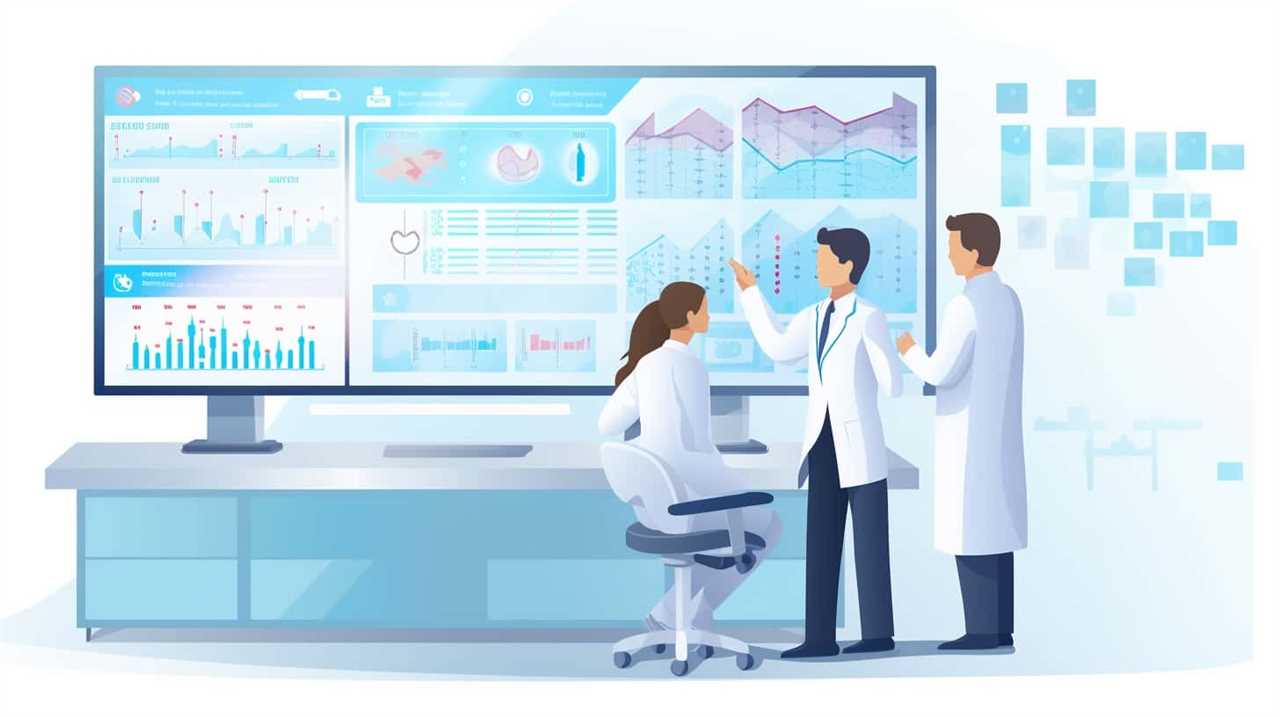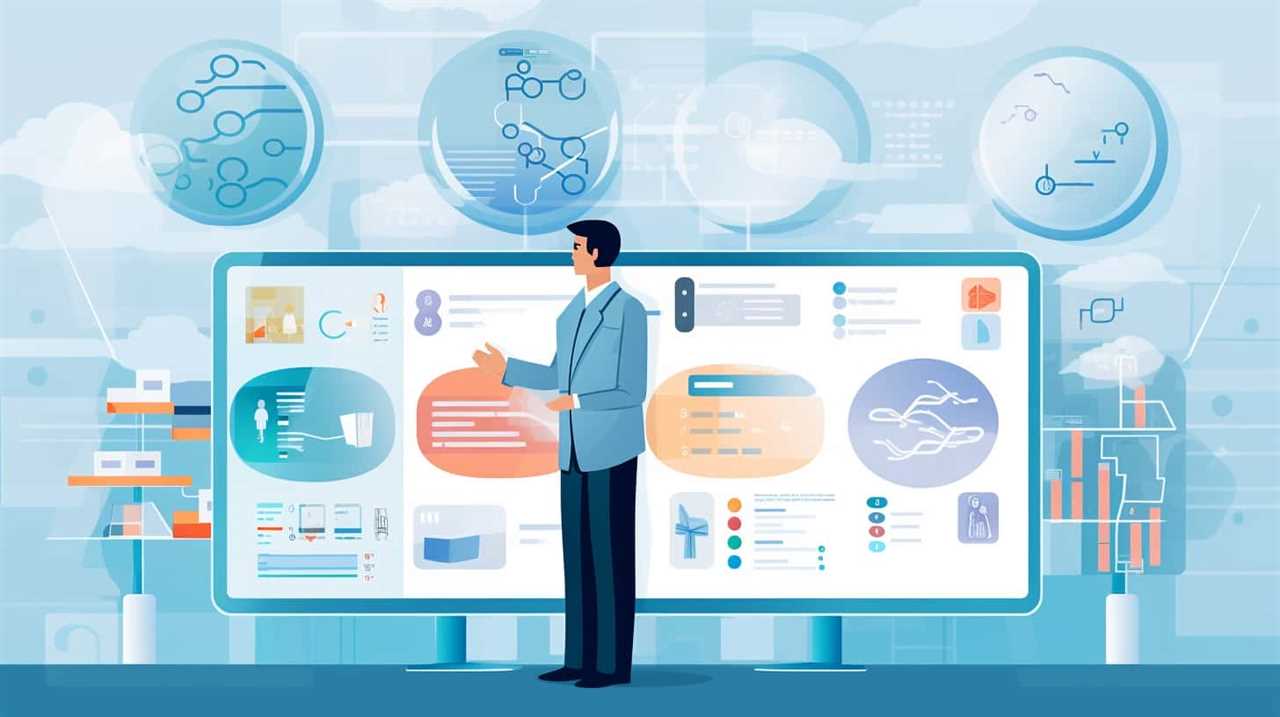Picture a scenario where small businesses have the ability to forecast future trends accurately and make informed decisions effortlessly with the assistance of data. Indeed, this is now a reality.
In this article, we present you with 11 essential predictive analytics tips tailored specifically for small businesses.
From choosing the right tool to analyzing data patterns, enhancing customer experience to improving operational efficiency, we’ve got you covered.
So, fasten your seatbelts and get ready to master the art of predictive analytics for your business success.
Key Takeaways
- Predictive analytics provides valuable insights and actionable intelligence for small businesses
- Small businesses can gain a competitive edge through data-driven decision making
- Accurate demand forecasting and better inventory management are important benefits of predictive analytics for small businesses
- Small businesses can leverage predictive models and applications to optimize pricing, marketing campaigns, and customer engagement.

Importance of Predictive Analytics
The importance of predictive analytics lies in its ability to provide small businesses with valuable insights and actionable intelligence. Data-driven decision making has become a critical aspect of business strategy, and predictive analytics plays a crucial role in enabling this process.
By analyzing historical data and identifying patterns, predictive analytics helps businesses make informed decisions based on evidence rather than intuition or guesswork.
In the realm of supply chain management, predictive analytics offers significant benefits. It allows businesses to forecast demand, optimize inventory levels, and identify potential disruptions in the supply chain. With this information, businesses can better plan their production schedules, streamline operations, and improve overall efficiency.
By leveraging predictive analytics, small businesses can gain a competitive edge by making smarter and more strategic decisions.

Key Benefits for Small Businesses
One of the major benefits for small businesses in utilizing predictive analytics is the ability to gain actionable insights and make data-driven decisions. This can have a significant impact on small business growth.
Here are four key benefits of predictive analytics for small businesses:
- Improved customer targeting: By analyzing customer data, small businesses can identify patterns and trends to understand their target audience better. This enables them to tailor their marketing efforts and product offerings to meet customer needs and preferences.
- Enhanced operational efficiency: Predictive analytics can help small businesses optimize their operations by identifying inefficiencies and bottlenecks. By streamlining processes and improving resource allocation, businesses can reduce costs and increase productivity.
- Better inventory management: Predictive analytics can provide small businesses with accurate demand forecasting, helping them optimize inventory levels. This ensures that they have the right products in stock at the right time, reducing the risk of overstocking or stockouts.
- Competitive advantage: Small businesses that leverage predictive analytics gain a competitive edge by making data-driven decisions. They can anticipate market trends, identify emerging opportunities, and stay ahead of their competitors.

Choosing the Right Predictive Analytics Tool
When it comes to choosing the right predictive analytics tool for your small business, there are several considerations to keep in mind.
Evaluating predictive analytics options requires a thorough understanding of your business needs, available resources, and desired outcomes.
Tool Selection Considerations
We frequently evaluate and select the right predictive analytics tool for our small business. When choosing a tool, we consider several important factors:
- Functionality: We assess the tool’s capabilities in terms of data collection, analysis, and visualization. It’s crucial for the tool to support the specific needs of our business.
- Ease of use: We prioritize tools that are user-friendly and require minimal technical expertise. This ensures that our team can quickly adapt to the tool and start utilizing its features effectively.
- Scalability: We look for tools that can handle our growing data volume and accommodate future business expansion. Scalability is essential for long-term success.
- Integration: We consider how well the tool integrates with our existing systems and data sources. Seamless integration allows for streamlined data interpretation and analysis.
Evaluating Predictive Analytics Options
To ensure optimal predictive analytics implementation, it’s crucial to thoroughly evaluate and select the most suitable tool for our small business. Evaluating predictive models and comparing predictive analytics tools is a critical step in this process. It allows us to assess the capabilities and features of different tools and determine which one aligns best with our business needs.
When evaluating predictive models, it’s important to consider factors such as accuracy, scalability, interpretability, and ease of use. We should also assess the tool’s ability to handle large datasets and its compatibility with our existing systems and infrastructure.
In comparing predictive analytics tools, we should look at their predictive modeling techniques, such as regression analysis, decision trees, or neural networks. We should also consider the tool’s data visualization capabilities, flexibility in handling different data types, and support for automation and integration with other systems.

Collecting and Analyzing Data
To effectively implement predictive analytics, small businesses must actively collect and analyze data. Here are four essential tips for small businesses to optimize their data collection and analysis process:
- Define clear objectives: Clearly define what you want to achieve with your predictive analytics efforts. Set specific goals and metrics to measure the success of your data analysis.
- Identify relevant data sources: Identify the data sources that are most relevant to your objectives. This may include customer data, sales data, social media data, or any other data that can provide valuable insights.
- Implement data collection tools: Utilize data collection tools and software to efficiently gather and store the necessary data. This may include CRM systems, data management platforms, or even custom-built solutions.
- Analyze and interpret the data: Use statistical analysis techniques and data visualization tools to analyze and interpret the collected data. Extract meaningful insights and trends that can help drive data-driven decision making.

Understanding Data Patterns and Trends
As we delve into the topic of understanding data patterns and trends, it’s crucial for small businesses to identify predictive indicators that can help them make informed decisions.
By leveraging historical data, we can uncover patterns and trends that provide valuable insights into customer behavior, market trends, and business opportunities.
Understanding these patterns and trends allows us to anticipate future outcomes and adapt our strategies accordingly, giving us a competitive edge in the market.
Identifying Predictive Indicators
In our experience, small businesses can effectively identify predictive indicators by understanding data patterns and trends. This is crucial because predictive indicators play a vital role in forecasting future outcomes and making informed business decisions.
To help small businesses in this process, we recommend the following:
- Define your objectives: Clearly outline the specific goals you want to achieve with predictive analytics to guide your indicator selection.
- Choose the right tool: Select a predictive analytics tool that aligns with your business needs and provides robust capabilities for identifying indicators.
- Analyze historical data: Examine past data to identify patterns and trends that can serve as reliable indicators for future predictions.
- Continuously monitor and refine: Regularly review and update your predictive indicators as business conditions evolve to ensure accuracy and relevance.
Leveraging Historical Data
Our team leverages historical data to understand data patterns and trends. By analyzing past data, we gain valuable insights into how different variables interact and affect outcomes. This understanding is crucial for effective predictive modeling and data integration.
We examine the historical data to identify patterns and trends that can be used to make accurate predictions for the future. Through this process, we can uncover hidden relationships and correlations that may not be immediately apparent. By leveraging historical data, we can develop predictive models that can accurately forecast future outcomes and make informed business decisions.
This approach allows small businesses to optimize their operations and achieve better results based on data-driven insights.

Implementing Predictive Models
We found that utilizing predictive models is a key factor in driving success for small businesses. Implementing predictive algorithms and predictive modeling techniques can provide valuable insights and help businesses make informed decisions.
Here are four essential tips for implementing predictive models effectively:
- Define the objectives: Clearly define the goals and objectives of implementing predictive models. Identify the specific business problems or challenges that you want to address.
- Gather relevant data: Collect and organize relevant data that will be used for building predictive models. Ensure the data is accurate, complete, and representative of the problem you’re trying to solve.
- Choose the right modeling technique: Select the appropriate predictive modeling technique based on the nature of your problem and the available data. Consider techniques such as regression analysis, decision trees, or neural networks.
- Validate and refine the model: Test the predictive model using historical data and evaluate its performance. Refine the model based on the results and iterate the process to improve its accuracy and effectiveness.
Implementing predictive models requires careful planning and execution. By following these tips, small businesses can leverage predictive analytics to gain a competitive edge and drive growth.

Predictive Analytics for Sales and Marketing
When it comes to sales forecasting techniques, predictive analytics plays a crucial role in helping small businesses accurately predict future sales and customer behavior. By analyzing historical sales data, market trends, and customer demographics, businesses can identify patterns and make informed decisions about pricing, inventory management, and sales strategies.
Additionally, predictive analytics can also be applied to marketing data analysis, allowing businesses to optimize their marketing campaigns, target the right audience, and personalize their messaging for better customer engagement and conversion rates.
Sales Forecasting Techniques
To effectively predict sales and optimize marketing efforts, small businesses can employ various sales forecasting techniques using predictive analytics. By utilizing predictive modeling techniques, businesses can gain valuable insights into future sales trends and make data-driven decisions to improve their bottom line.
Here are four key sales forecasting techniques that small businesses can implement:
- Time Series Analysis: This technique analyzes historical sales data to identify patterns and trends over a specific time period. It helps businesses forecast future sales based on past performance.
- Regression Analysis: By examining the relationship between sales and various factors such as price, advertising, and customer demographics, regression analysis predicts future sales based on these variables.
- Market Research Surveys: Gathering data through surveys and market research helps businesses understand customer preferences and demand, enabling them to forecast sales accurately.
- Machine Learning Algorithms: These algorithms use historical sales data and other relevant factors to make accurate predictions about future sales, taking into account complex patterns and interactions.
Implementing these sales forecasting techniques can provide small businesses with valuable insights to make informed decisions and drive growth.
Marketing Data Analysis
Continuing the discussion on sales forecasting techniques, let’s delve into the importance of marketing data analysis in predictive analytics for sales and marketing.
In today’s competitive business landscape, it’s crucial for small businesses to effectively analyze their marketing data to gain actionable insights. Data visualization plays a key role in this process, allowing businesses to visually represent complex data sets and identify patterns or trends.
By segmenting their customer base, businesses can better understand the needs, preferences, and behaviors of different customer groups. This enables targeted marketing campaigns, personalized customer experiences, and improved customer retention.
Furthermore, marketing data analysis helps businesses optimize their marketing strategies, allocate resources more effectively, and make data-driven decisions for future growth.

Enhancing Customer Experience
In order to optimize customer experience, we must focus on creating personalized interactions throughout the customer journey. By implementing personalization techniques, we can enhance customer loyalty and satisfaction. Here are four essential strategies to enhance the customer experience:
- Utilize customer data: Analyze customer data to understand their preferences, behavior, and purchase history. This will enable you to tailor your interactions with each customer, providing them with relevant and personalized experiences.
- Implement targeted marketing campaigns: Leverage predictive analytics to segment your customer base and create targeted marketing campaigns. This approach ensures that your customers receive personalized offers and recommendations based on their individual needs and preferences.
- Provide seamless omni-channel experiences: Enable customers to interact with your business through multiple channels, such as online, mobile, social media, and in-store. Ensure that their experience is consistent across all channels, allowing for a seamless and personalized journey.
- Continuously optimize and iterate: Regularly analyze customer feedback and engagement metrics to identify areas for improvement. Use this data to refine your personalization techniques and enhance the overall customer experience.

Improving Operational Efficiency
Now that we’ve enhanced the customer experience by implementing personalized interactions, let’s focus on improving operational efficiency.
To achieve this, small businesses must prioritize measuring productivity and optimizing workflows.
Measuring productivity involves quantifying the output of various operational processes and identifying areas for improvement. By analyzing key performance indicators (KPIs) such as production rates, employee efficiency, and resource utilization, businesses can gain valuable insights into their operational efficiency. This data-driven approach enables them to identify bottlenecks, eliminate redundancies, and streamline processes.
Optimizing workflows involves reevaluating and reengineering existing processes to maximize efficiency. By identifying and eliminating unnecessary steps or tasks, businesses can reduce waste, improve resource allocation, and enhance overall productivity.
Small businesses should leverage predictive analytics tools to analyze data, identify trends, and make informed decisions to continuously improve their operational efficiency.

Making Data-Driven Decisions
To effectively utilize predictive analytics, we must rely on data to drive our decision-making process. Data-driven decision making allows us to make informed choices based on evidence rather than intuition or guesswork. By leveraging data analysis techniques, we can uncover valuable insights that guide our business strategies and actions.
Here are four key ways to make data-driven decisions:
- Define clear objectives: Clearly articulate the goals and objectives you want to achieve through data analysis.
- Collect relevant data: Gather high-quality, relevant data from reliable sources to ensure the accuracy and validity of your analysis.
- Analyze and interpret the data: Use appropriate data analysis techniques to uncover patterns, trends, and correlations that can inform your decision-making process.
- Make informed decisions: Based on the insights gained from data analysis, evaluate different options and choose the one that aligns best with your objectives and goals.

Overcoming Challenges in Predictive Analytics Implementation
We can overcome challenges in implementing predictive analytics by addressing potential obstacles head-on.
The implementation of predictive analytics can be complex, and businesses may face various challenges along the way. One common challenge is the lack of data quality and availability. To tackle this, businesses need to ensure that their data is accurate, reliable, and comprehensive.
Another challenge is the integration of predictive analytics into existing systems and processes. This can be overcome by carefully planning and strategizing the implementation process, involving key stakeholders, and providing proper training and support.
Additionally, businesses should consider the scalability and flexibility of their predictive analytics solution to accommodate future growth and changes.

Frequently Asked Questions
What Are the Limitations or Drawbacks of Using Predictive Analytics for Small Businesses?
There are limitations and drawbacks of using predictive analytics for small businesses. These include the need for large amounts of data, potential inaccuracies in predictions, and the requirement for expertise in data analysis.
How Can Small Businesses Ensure the Accuracy and Reliability of Their Predictive Analytics Models?
To ensure the accuracy and reliability of our predictive analytics models, we focus on data validation and thorough model evaluation. This helps us maintain a high level of confidence in our predictions and make informed business decisions.
What Are Some Common Mistakes or Pitfalls to Avoid When Implementing Predictive Analytics in a Small Business?
When implementing predictive analytics in a small business, we must be aware of common challenges and pitfalls. It’s crucial to follow best practices and avoid mistakes to ensure accurate and reliable results.
Are There Any Ethical Considerations or Concerns When Using Predictive Analytics in Small Businesses?
Ethical considerations and privacy concerns are vital when using predictive analytics in small businesses. We must ensure that we adhere to appropriate data protection measures and avoid any potential biases or discriminatory outcomes.
Can Predictive Analytics Be Used to Forecast the Impact of External Factors or Market Trends on Small Businesses?
Yes, predictive analytics can be used to forecast the impact of external factors and market trends on small businesses. By analyzing data from social media and forecasting customer behavior, businesses can make informed decisions to stay ahead of the competition.

Conclusion
In conclusion, implementing predictive analytics can be a game-changer for small businesses. By harnessing the power of data and leveraging the right tools, businesses can gain valuable insights, improve customer experience, and enhance operational efficiency.
Although challenges may arise during implementation, the benefits of predictive analytics outweigh the risks. So, don’t hesitate to embrace this technology and take your small business to new heights of success.









